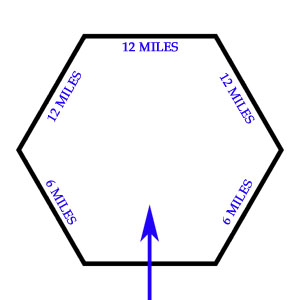Go to Part 1
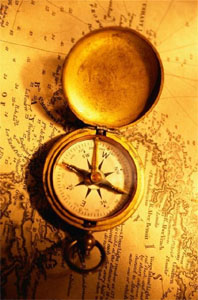 In general, you can either navigate through the wilderness by landmark or you can navigate by compass direction.
In general, you can either navigate through the wilderness by landmark or you can navigate by compass direction.
NAVIGATING BY LANDMARK
Generally speaking, it’s trivial to follow a road, river, or any other natural feature of the terrain. It’s similarly easy to head towards any visible landmark. The landmark or terrain feature will determine the route of travel and there’s no chance of becoming lost, so you can simply track the number of miles traveled.
IDENTIFYING LANDMARKS: If the PCs are unsure of a landmark but have had previous experience with it, it may be possible to identify it with a Survival check at the DM’s discretion. The accuracy and detail of the identification will depend on prior experience.
Example: A ranger is passing through the woods when they encounter a river. If it’s a river they’ve walked up and down before, the Survival check might let them confirm that it is, in fact, the Mirthwindle. If they’re less familiar with the region, the check might tell them that this is probably the same river they crossed earlier in the day – it must be taking a southerly bend. If this is the first time they’ve ever seen this river, the Survival check won’t tell them much more than “this is a river”.
NAVIGATING BY COMPASS DIRECTION
Characters trying to move in a specific direction through the wilderness must make a navigation check using their Survival skill once per watch to avoid becoming lost.
A character with at least 5 ranks in Knowledge (geography) or Knowledge (local) pertaining to the area being traveled through gains a +2 synergy bonus on this check.
BECOMING LOST: Characters who fail the navigation check become lost and veer away from their intended direction of travel, as indicated by a 1d10 roll on the diagram below. When lost characters exit a hex, they will exit through the face of the hex indicated by the die roll.
Note: Characters who are lost remain lost. In the new hex neither their intended direction of travel nor their veer will change.
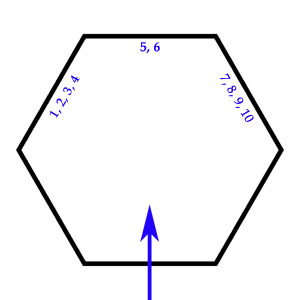
If characters who are already lost fail another navigation check, their veer can increase but not decrease.
Example: A lost party is already veering to the left when they fail another Navigation check. A roll of 1-4 on 1d10 would cause them to exit two hex faces to the left of their intended direction, but any other result would not change their veer at all.
ALTERNATIVE VEERS:
Absolute Degree: Roll (1d10 – 1d10) x 10 to determine the number of degrees off-course.
Compass Direction: Roll 1d10 and consult the diagram below. (The blue arrow indicates the intended direction of travel.)
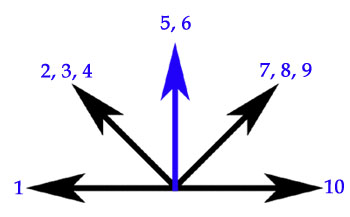
USING A COMPASS: Compasses grant a +2 bonus to navigation checks. In addition, they automatically eliminate veer at hex borders even if the user doesn’t recognize that they were lost. (Even if you don’t recognize that you ended up off course, the compass constantly reorients you towards your intended direction of travel.)
LOST CHARACTERS
Recognizing That You’re Lost: Once per watch, a lost character can attempt a Survival check against the Navigation DC of the terrain to recognize that they are no longer certain of their direction of travel.
Characters who encounter a clear landmark or unexpectedly enter a distinctly new type of terrain can make an additional Survival check to realize that they’ve become lost.
Note: Some circumstances may make it obvious to the characters that they have become lost without requiring any check.
Reorienting: A character who realizes that they’ve become lost has several options for re-orienting themselves.
Backtracking: A lost character can follow their own tracks (see Tracking, below). While tracking allows them to retrace their steps, they must still recognize the point at which they went off-track. If a character is successfully backtracking, they may make a Survival check each watch (using the Navigation DC of the terrain). If the check is successful, they’ll correctly recognize whether they were previously on-track or off-track. If the check is a failure, they have a 75% chance of reaching the wrong conclusion.
Compass Direction: It requires a Survival check (DC 12) to determine true north without a compass or similar device. On a failed check, randomly determine the direction the character thinks is true north.
Setting a New Course: A lost character can attempt to precisely determine the direction they should be traveling in order to reach their desired objective by making a Survival check (Navigation DC of the terrain + 10). If the character fails the check, they immediately become lost. Determine their direction of travel like any other lost character.
Conflicting Directions: If several characters in a single party all attempt to determine the correct direction of travel, make their Survival checks secretly. Tell the players whose characters succeeded the correct direction in which to travel, and tell the other characters a random direction they think is right.
FINDING LOCATIONS
The difficulty and complexity of finding a specific location within the wilderness varies depending on the character’s familiarity and approach.
VISIBLE LOCATIONS: As described under Exploration Encounters, some locations are visible from a great distance. Characters within the same hex as the visible location (or within a certain number of hexes, as indicated by the key) automatically spot a visible location.
ON ROAD: If a location is on a road, river, or similar trail, then a character following the road, river, or trail will automatically find the location. (Assuming it isn’t hidden, of course.)
FAMILIAR LOCATIONS: Familiar locations are those which a character has visited multiple times. Characters within the same hex as a familiar location can be assumed to automatically find the location. (Within the abstraction of the hexmapping system, they’ve demonstrated sufficiently accurate navigation.) Under certain circumstances, characters may also be considered “familiar” with a location even if they’ve never been there. (Possibilities include possessing highly accurate topographic maps, receiving divine visions, or using certain types of divinatory magic.)
Note: If characters are flailing about in their efforts to find a familiar location – by repeatedly “missing the hex”, for example – the DM can decide to treat the location as being unfamiliar until they find some way to reorient themselves.
UNFAMILIAR LOCATIONS: Unfamiliar locations (even those a character has been to previously) are found using encounter checks.
Characters spending time to specifically search a particular area enter exploration mode. They make no progress towards exiting their current hex, but the DM continues making the necessary encounter checks (to represent the result of their search).
If the party is looking for something specific that they suspect might be in the area, the DM may allow a third check each watch for that location and only that location. (Any other encounter indicated is ignored. Obviously if the location they’re looking for isn’t in the current hex you can skip this check – they are, after all, looking in the wrong place.)
Note: The extra check represents their ability to narrow their search based on the information they have available. If they don’t have enough information to narrow the search, don’t make the extra encounter check. Alternatively, if they’re somewhat familiar with a location the extra encounter check may be employed and any success used to indicate to them that they’re not in the right area.
Go to Part 4: Encounter Tables
This material is covered by the Open Game License.

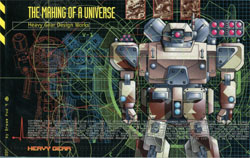
 In general, you can either navigate through the wilderness by landmark or you can navigate by compass direction.
In general, you can either navigate through the wilderness by landmark or you can navigate by compass direction.


